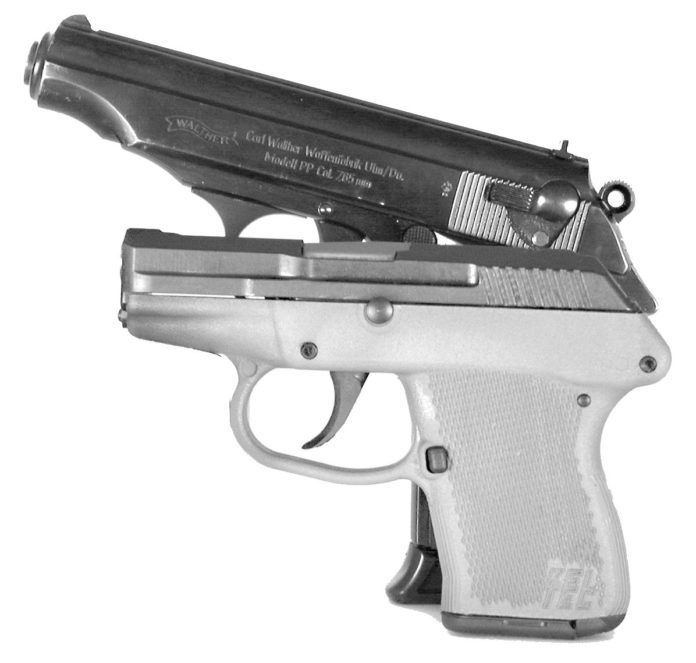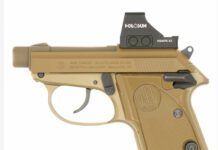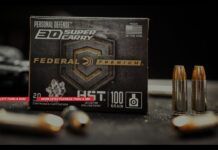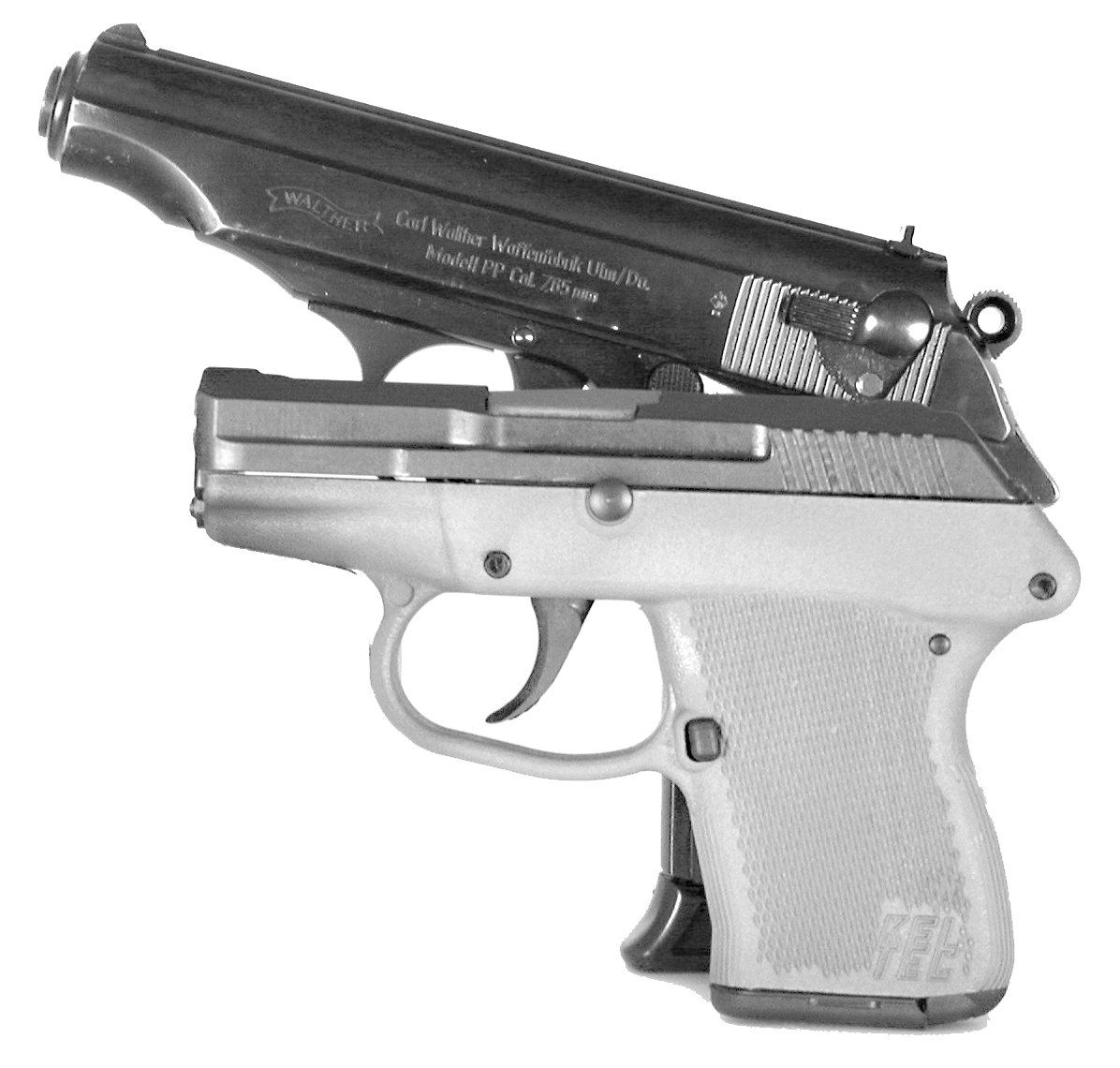
At Gun Tests, we believe that every gun and every cartridge has its place, though we sometimes disagree with the manufacturer about what that place is (sometimes it’s in the trash).
In this evaluation, we take a hard look at three .32 ACP pistols whose existence poses the question, Is something always better than nothing? By this we mean, is a pip-squeak pistol better than a knife or your hands or a tire iron, if the task at hand is self defense and not changing a flat?
Toward that end, we tested three small .32s whose primary sales angle is portability, not power. They were Walther’s PP, at $499 a classic due to design and structural integrity. In contrast, Kel-Tec’s polymer P32, $295, seems like it shouldn’t last the week, but it is on the verge of developing a cult-like following, judging from GT reader requests for us to test it. Beretta’s Tomcat re-emerges with a special oversized front sight from AO and a new name, the Alley Cat, that sounds more like a fighter than a lover. Several features make our test pistols distinctly different, yet the objective of these pistols is solely self defense at very close quarters. Some would refer to the two smaller guns in this test, the Alley Cat and the P32, as “belly guns” best fired within arms’ length. The Walther .32s are available in two sizes, but even the PPK model (which is smaller than the model PP we test-fire here) is substantially larger and heavier than either the Beretta or Kel-Tec. We thought it would be interesting to see how much farther, if any, the Walther could stretch the effectiveness of the relatively puny .32 ACP cartridge.
According to Krause’s 512-page Cartridges of the World, the .32 ACP cartridge was designed by John Browning for his first successful automatic pistol. First manufactured in 1899 by FN in Belgium, it was marketed to the United States when Colt turned out a pocket automatic. The Colt Model 1903 and its descendants can be seen being used (usually by bad guys) in such movies as Devil in a Blue Dress and Hollywood Confidential. Not only is the .32 Automatic Colt Pistol one of the most popular cartridges ever developed, it is also one of the most deadly, even if it lacks instant stopping power. The round is slim enough and powerful enough to ensure penetration. But once inside, it is also likely to cut and smash an attacker’s vitals rather than exit.
These performance questions are outside our charge for this test, and we instead focus on such “boring” but necessary details as function, accuracy, and handling capabilities, especially when drawn from concealment.
Range Session
Many people believe that most attacks involving a firearm take place at 7 yards or less. Many argue closer still. For our accuracy testing, we shot each pistol supported by sandbags at a 3.33-inch circle from a distance of 21 feet. This taught us how to handle the available sights and the single-action trigger on both the Beretta and the Walther and the Kel-Tec’s double-action only (DAO) mechanism. Our choice of ammunition included two full-metal-jacketed rounds weighing 71 grains from Federal and Winchester, respectively. We found the most widely available hollowpoint ammunition to be Winchester’s 60-grain Silvertips, so we tested with this cartridge as well.
Our second test was designed to tell us more about rapid presentation. We used the paper B-27E target commonly used by law enforcement for handgun qualification. This target portrays a silhouette roughly equivalent in size to a man of medium height and build. Placed at 7 yards down range, we fired two five-shot groups of the Winchester Silvertips as rapidly as possible from sights on target. The Beretta and the Walther were fired in both traditional double-action mode (double to single-action) and then strictly single action only. We recorded elapsed times and the number of hits on target. We were constantly on the lookout for clues that would tell us about the emergency handling characteristics of these pistols, especially how a shooter might perform cold. In fact, we made it a point to separate our bench session and this speed shoot.
The legal arena favors the language and purpose of carrying a concealed handgun to stop aggression, and not necessarily to kill. The .32 ACP cartridge is not considered a fight stopper, but due to penetration it is often deadly nonetheless. Thus, shot placement under stress is critical. We hoped our series of tests would offer valuable insights along this line.
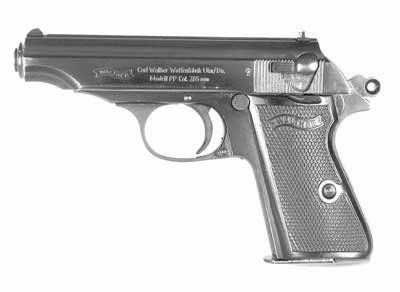
Walther PP32, $499
Officially, the Walther PP and PPK pistols are no longer imported. However, supply is actually available through a repurchase and restoration program headed by Earl’s Repair Service in Tewksbury, Massachusetts, a major Walther importer and representative.
Why test pre-owned pistols? We doubt this would be feasible with many of today’s pistols, but the steel construction of the Walther firearms, combined with lighter chamberings, should help them last forever. The PP’s action and fit were jewel-like, the only real hint that this pistol was not brand new was minor wear to the bluing on the front of the slide.
The top of the slide was flattened and scribed to reduce glare, but we still would have preferred to add serrations to the brief front sight blade for this same reason. The rear sight was windage adjustable, but we found this pistol to be dead on. We did manage to shoot a single hole at 7 yards and found the PP capable of plinking successfully at more than five times that distance. It should be pointed out that this pistol was not solely designed for close combat but for training as well. Earl Sheehan pointed out that the .32 ACP model was preferred for practice sessions over the .380 ACP models due to its lighter recoil.
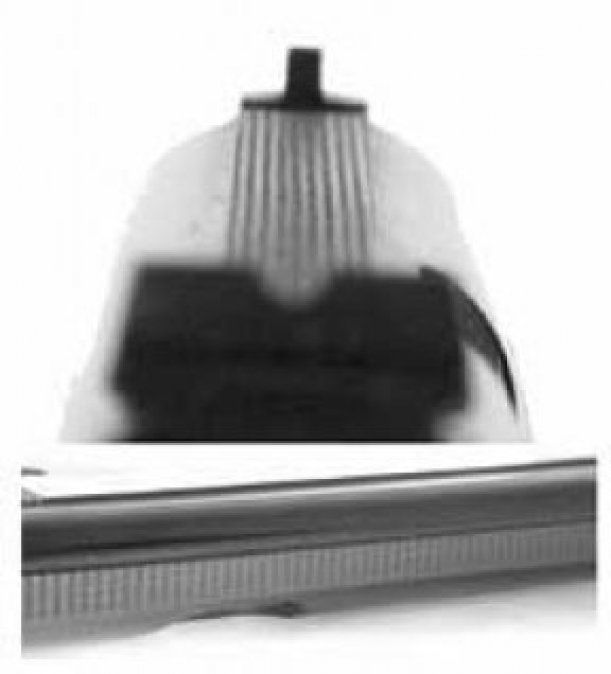
We would like to have matched this pistol with an early Colt model for accuracy and ballistics. Both the Colt and the Walther are equally concealable and snag free. The PP is slim like the Colt and offers rear cocking serrations on the slide and a rounded hammer that is both lined for grip and relieved to reduce mass. The Walther, however, features a hinged trigger that can fire both double and single action. This feature has since become known as Traditional Double Action (TDA). For single action only fire, the hammer can be thumbed back, but at this point there is no safety mechanism. Instead, the hammer can be lowered safely by a depressing the decocker lever on the left side of the frame. This lever will then remain down to deactivate the trigger. Pushing the lever forward to its horizontal position reconnects the trigger, but the first shot will be double action.
We found the single-action trigger to be smooth and its movement felt like the finely weighted action of a grand piano. Also, unlike the somewhat abstract sight pictures of the Alley Cat or the Kel-Tec, we always knew how to line up our shots and control them throughout our press.
Trigger-wise, when firing our practical test, we found that the double-action press was inordinately heavy at more than 16 pounds. Compared to just 5 pounds for single action, this made the transfer from DA to single action distracting. We are sure that the Walther trigger can be adjusted to be much lighter, but we can understand Walther’s position on this taking into account today’s litigious climate.
In the mean time our elapsed times firing single action only at the B-27E target were 1.81 and 1.90 seconds respectively. Average shot to shot time (split-time) was just over 0.30 seconds for each run.
The biggest difference was reaction time between the single action only runs and the TDA format. Here, the longer, more difficult trigger added as much as 0.30 seconds to the time elapsed from the start signal of our Competition Electronics Pocket Pro timer ($139.95, Brownells 641-623-4000) to the first recorded shot. First shots SA were 0.67 and 0.62 seconds from the start, but firing double action took 0.92 and 0.90 seconds respectively. However, comparing the TDA strings to the SA strings, accuracy was very nearly the same. Firing the Walther we collect one X, one 10, three 9s, two 8s, and one 7-ring hit, with two misses.
What we didn’t like when firing our Walther PP32 DA to SA was that it took so much more concentration. Personally, if we owned this pistol we would have the DA trigger relieved by a professional that has experience working on the Walther pistol, but training and familiarity would certainly improve this performance.
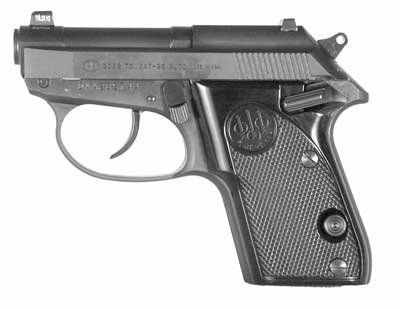
Beretta Alley Cat, $368
Of the three pistols in this test, the Alley Cat is the only model that can be cocked and locked. Beretta recommends this mode of carry for law-enforcement personnel only, however. This seems wise because we would not consider pocketing this gun or any other in a cocked and locked mode. Furthermore, Beretta prefers that the hammer be lowered and the safety engaged. This can be safely accomplished despite the absence of a decocking lever.
Beretta models chambered for calibers ranging from .380 to .22 LR utilize a tip-up barrel. This means the chambered round is carried in the dislodged barrel away from the breechface. The hammer can now be lowered, and since the firing pin is of inertial design, accidental discharge is almost impossible. The engaging of the safety with hammer down should remove the word “almost” from the previous sentence.
Basic disassembly is also related to the tip-up barrel. Swinging the barrel all the way up on the hinge releases the slide, which in Beretta tradition is remarkably brief. The tip-up framed Berettas are charming little devices. The Alley Cat differs only from the other .32 ACP mini-gun in its lineup, the Tomcat, with the addition of an AO (formerly Ashley Outdoors) big dot (Trilux H3) sight. This sight is a 0.16-inch white dot dovetailed into the slide that sports a tritium dot in the center. The rear sight is also an AO product that is more a crease than a notch. The center point is accented with a white vertical line. For truly rapid acquisition we would rather have seen the large front dot be entirely tritium. As it was, we thought the front dot was too coarse to regulate elevation, and the rear blade too vague to perceive windage.
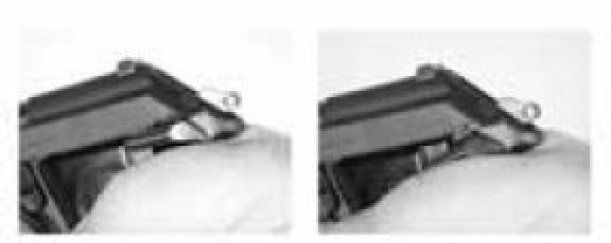
In our rapid-fire test at 7 yards, we felt that so much of the gun was inside our hand that referring to the sights was unnecessary. In the dark a bigger tritium dot might be preferred, however.
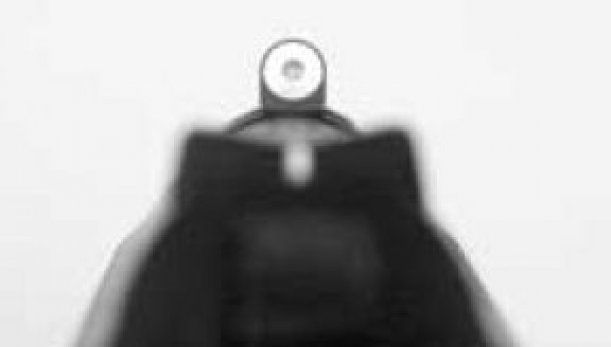
Without what we thought was a completely satisfactory set of sights, accuracy was still acceptable. Frankly, we were never sure about our sight alignment for bench work. Feedback during the press was not really possible. Still, is this an issue for a weapon that is designed for the closest of shooting? We doubt it.
For the record the Walther shot all groups under 1 inch, and firing the Winchester Silvertips, groups from the Alley Cat measured 1.5 inches or less. Only the Federal rounds flew beyond the 2.0-inch diameter at 7 yards.
During the bench session with this gun, we did experience the only severe malfunction of the test, but we are sure is ammunition related. Early in our test session, the primer of a Federal round broke upon ignition, failing to dislodge the bullet. The flash hole inside the case was indeed all the way through, but we theorize that the ignition of the primer was spent on breaking the cup and not lighting the powder. The firing pin hit the primer dead center and we have no reason to believe that the Beretta was at fault.
Other malfunctions during our tests were stoppages that were positively traced to the shooter’s thumb or other portion of the hand rubbing against the slide, interrupting its cycle. This only occurred with the two smaller pistols and its a fact of life one must consider before purchasing one of them.
If you have larger hands you may find it difficult to properly grip and operate guns such as the Beretta Alley Cat and the Kel-Tec P32. The result could be simple abrasion, or worse, a malfunction during a moment of peril. Lack of available grip is just another element of carrying these types of weapons.
Firing as fast as possible at the qualifying target, we saw a marked difference in accuracy between single action only and TDA fire. Because the transition is not nearly as noticeable, our times in each mode were much closer than the Walther’s in the same experiment. Perhaps we were just rushing too much.
In TDA fire we suffered three misses while landing no X-ring hits, one 10, five 9s, and one 8-ring shot. In single action only, however, we had our only clean performance of the test with no X-ring hits, two 10s, four 9s, three 8s, and one seven ring shot. Elapsed time ranged from 1.67 to 1.80 seconds throughout. First shots SA were 0.76 and 0.71, and only 0.80 and 0.79 DA. Average split times across the board were 0.25 seconds. The difference in split times between DA and SA trigger strokes were negligible. Perhaps if we had slowed down during the transition from DA to SA we would not have suffered any misses at all, but in measuring the split time between the final shots (fired SA) we find another more likely possibility. The last split was only 0.13 seconds after a split of 0.22 seconds. Attention to accuracy aside, this proves that the Beretta Alley Cat can be fired very quickly, as fast as any USPSA race gun at close quarters.
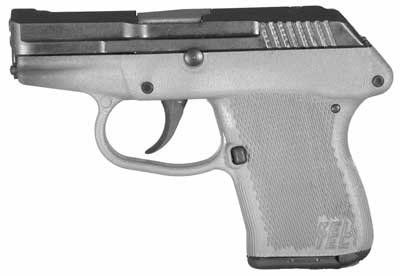
Kel-Tec P32, $295
Of our three test guns, the Kel-Tec P32 is by far the lightest, smallest, easiest to conceal and operate. To load the chamber, the slide must be pulled back manually as there no exterior slide lock. There are no levers to operate beyond the trigger itself. At rest the hammer is blocked and can only be set free by actually pulling the trigger.
The gun is ultra lightweight at 9 ounces. The grip is Du Pont ST-8018 plastic, and compared to the Beretta or the Walther, it seems like you could step on the P32 and break it. In reality it is not that easy.
The grip is very narrow, but the molded-in “checkering” provides excellent grip. The magazine release protrudes from the left side, but the spring is heavy enough to prevent accidentally releasing the mag. The only real pitfall is getting too much hand on the pistol and contacting the slide, which could cause abrasion or a simple malfunction.
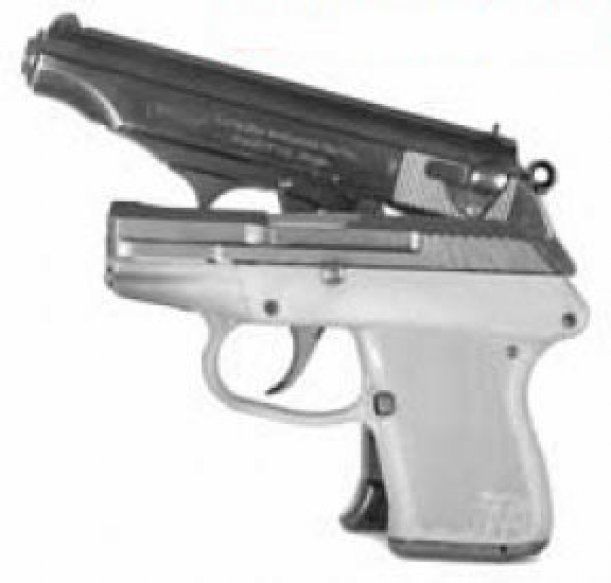
The trigger is double action only; thus, the shooter need only concern himself with pressing and releasing the trigger smoothly and equally forward and back. This is a big advantage, in our opinion, especially under stress. We often see arguments over how to draw, how to clear a jam, how to stand. But the most successful firearms instructors preach simplified options as the way to survive in combat. One necessary motor skill clearly defined and strictly ingrained beats a full menu of techniques under stress. That may be one reason why the Kel-Tec P32 had the fastest time over the course of our practical test. While producing nine out of ten hits on target (one X, two 10s, two 9s, one 8, and three 7-ring hits), overall elapsed times for the two runs were 1.71 and 1.72 seconds. First shots rang out at 0.41 and 0.49 seconds respectively. While not as impressive in the hand as either the Walther or the Beretta weapons, with these times it served the purpose of a close-quarters deep concealment piece the best, in our view.
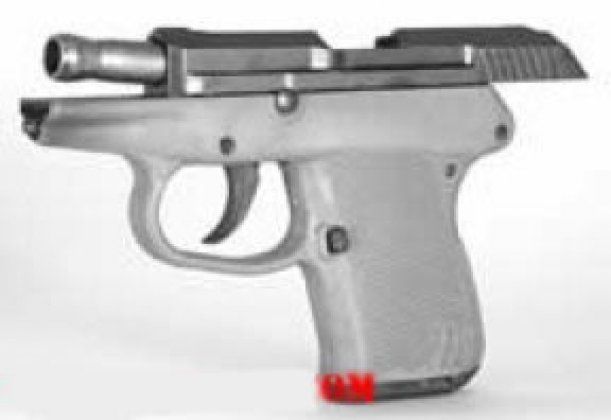
At the bench it took some shooting to realize that gauging elevation with the supplied sights (for lack of a better word) was a challenge. The white insert guide-points were easier to reconcile right and left than up and down. Mounting the targets on the same level as the pistol produced the best results. Asking the sights to report to the shooter an adjustment in elevation was asking too much. But on the B-27E silhouette, hits and split times were consistent. Split times varied only from 0.29 to 0.33 second for an average of 0.32 second. While this is not a blistering pace, it is one that was consistent and provided enough accuracy for effective shot placement. Despite being available in a range of colors, this is not a toy.
Gun Tests Recommends
Any judgment regarding small-caliber weaponry for self-defense starts with the question, “Would I stake my life on the stopping power of this caliber?” In our view, the .32 ACP is underpowered as a self-defense cartridge, unless it’s what is available. If the weight and size of a gun is extremely important in your ability to carry it, then eight .32 ACP rounds beat nothing.
Walther PP32, $499. Conditional Buy. This gun is bigger and heavier than the others, and there’s some question about supply. But it is well-made and competent. Still, why not get it in the slightly more powerful .380 ACP instead? Or, why not buy a compact 9mm with the same dimensions?
Beretta Alley Cat, $368. Conditional Buy. For close-in work, this may be a good choice for some shooters. But the design may be too complicated for others. Also, we prefer the Kel-Tec.
Kel-Tec P32, $295. Buy It. Many people are looking for the least expensive weapon, and in some cases that’s foolish. Not here. This pistol delivered everything it said it would. If you only need the basics of DAO operation and plastic is OK, then this is worth the dollars.




























